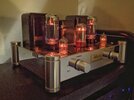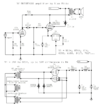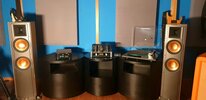I knew I couldn't expect much out of it, but after watching a favorable online review of the Reisong A10 amp and reading a few others, I bit the bullet and found one available with two desired options: 1) no tubes, and 2) point-to-point wired. My thinking is that the cheap tubes that ship with these amps usually aren't good, and I could provide my own. And, with it being point-to-point wired, it would make future upgrades and repairs easier. I was into it for $160 plus shipping from the far east.
I use this in my computer desktop system attached to an older DACMagic DAC (which needs replacing--it's woefully out of date) and a newer pair of KEF LS50s. Part of my reason for "overkill" on the speakers was that I sometimes need to do some audio or video editing, or analyze something closely, and the previous pair of speakers I used came with an awful resonance at 125Hz that made them tubby sounding. (I had to use a really deep notch filter to get rid of some of it.) The LS50s were a killer deal at the time, so I didn't pay anywhere near list price for them. I pair them with a small subwoofer beneath the desk.
The A10 does sound good, but I felt the KEF LS50s sounded too bright in my main system. (I normally listen to stats.) On the desktop, though, the more relaxed sound of the A10 worked in their favor. Maybe you can see where this is leading.
Only last week did I get a chance to try the A10 in my main system. And let me just put it politely--I lasted three tunes and had to yank the A10 out. It was that bad. The nearest equivalent was the garbage I used to buy from Radio Shack in the late 70s (I had that SA-1000A integrated amp which, surprisingly, sounds very similar to this.) What did I hear? Three things. 1) The highs feel as though I had cotton stuffed in my head; this amp is quite rolled off. Much of the detail was missing. 2) The sound was a bit grainy. 3) While the left-to-right spread was about the same, the soundstage was flat. No depth at all.
Was it fair to pit it against an amp that was probably 15 times the cost when new? Maybe not, but if you read the hyperbole from others who own it, it makes you wonder what it is they're hearing that's so special about this A10.
For the record, I'm using Electroharmonix 6CA7 and Voshkod 6N2 tubes (which supposedly are well-regarded). The rectifier I bought was a Tung-Sol 5AR4, as the 5Z4 Mullard I'd ordered was in the bowels of USPS for several weeks before it finally arrived. (The 5AR4 is electrically close enough to the 5Z4 to work properly.) I can rewire the 6N2 sockets for 12AX7s quite easily, and may do that if I decide to keep the amp.
As it stands, the A10 has been an interesting experiment but I don't have the time or patience right now to see if it can be improved on. (Without a schematic, that would be a bit difficult anyways.) I'm probably going to get a Sprout for the desktop instead, as it's a cleaner and more neutral amp, and the built-in DAC is more capable than what I'm using now. (Plus, it will use less space.) The KEFs deserve better.

To be continued...
I use this in my computer desktop system attached to an older DACMagic DAC (which needs replacing--it's woefully out of date) and a newer pair of KEF LS50s. Part of my reason for "overkill" on the speakers was that I sometimes need to do some audio or video editing, or analyze something closely, and the previous pair of speakers I used came with an awful resonance at 125Hz that made them tubby sounding. (I had to use a really deep notch filter to get rid of some of it.) The LS50s were a killer deal at the time, so I didn't pay anywhere near list price for them. I pair them with a small subwoofer beneath the desk.
The A10 does sound good, but I felt the KEF LS50s sounded too bright in my main system. (I normally listen to stats.) On the desktop, though, the more relaxed sound of the A10 worked in their favor. Maybe you can see where this is leading.
Only last week did I get a chance to try the A10 in my main system. And let me just put it politely--I lasted three tunes and had to yank the A10 out. It was that bad. The nearest equivalent was the garbage I used to buy from Radio Shack in the late 70s (I had that SA-1000A integrated amp which, surprisingly, sounds very similar to this.) What did I hear? Three things. 1) The highs feel as though I had cotton stuffed in my head; this amp is quite rolled off. Much of the detail was missing. 2) The sound was a bit grainy. 3) While the left-to-right spread was about the same, the soundstage was flat. No depth at all.
Was it fair to pit it against an amp that was probably 15 times the cost when new? Maybe not, but if you read the hyperbole from others who own it, it makes you wonder what it is they're hearing that's so special about this A10.
For the record, I'm using Electroharmonix 6CA7 and Voshkod 6N2 tubes (which supposedly are well-regarded). The rectifier I bought was a Tung-Sol 5AR4, as the 5Z4 Mullard I'd ordered was in the bowels of USPS for several weeks before it finally arrived. (The 5AR4 is electrically close enough to the 5Z4 to work properly.) I can rewire the 6N2 sockets for 12AX7s quite easily, and may do that if I decide to keep the amp.
As it stands, the A10 has been an interesting experiment but I don't have the time or patience right now to see if it can be improved on. (Without a schematic, that would be a bit difficult anyways.) I'm probably going to get a Sprout for the desktop instead, as it's a cleaner and more neutral amp, and the built-in DAC is more capable than what I'm using now. (Plus, it will use less space.) The KEFs deserve better.

To be continued...




